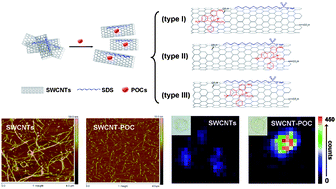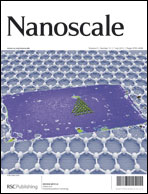Enhanced dispersibility and cellular transmembrane capability of single-wall carbon nanotubes by polycyclic organic compounds as chaperon†
Abstract
The common aggregation of single-wall carbon nanotube (SWCNT) in solution is the critical obstacle to elucidate their unique physico-chemical characteristics and biological properties. Therefore, it is very important to overcome this barrier through manipulation of the weak interaction of small molecules with nanotube surface limited interface. A highly dispersed SWCNT system was achieved by binding with polycyclic organic compounds (POCs) including rhodamine 123, ethidium bromide, fluorescein isothiocyanate and 1-pyrene butyric acid as chaperons, in cooperation with sodium dodecyl sulfate. POCs were believed to penetrate through the interstices of aggregated SWCNTs and bind with individual SWCNTs to form highly dispersed and stable SWCNT–POC–surfactant conjugates in both water and phosphate buffer–serum solution, confirmed by gel electrophoresis, transmission electron microscopy and atomic force microscopy. The possible binding interaction includes π–π stacking with side-wall, electrostatic interactions with defect sites and coating surfactants. Compared to pristine SWCNTs, individual SWCNT–POC conjugates had improved transmembrane passage ability through both endocytosis and diffusion pathways, validated by laser scanning confocal microscopy and micro-Raman mapping techniques. For the applications of SWCNTs in drug delivery, in vitro imaging and other research fields, this novel strategy could provide highly dispersed SWCNTs with better efficiency of drug loading and stability.


 Please wait while we load your content...
Please wait while we load your content...